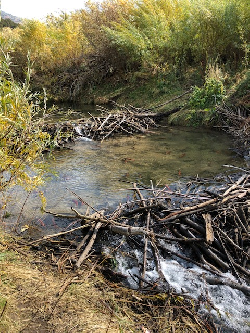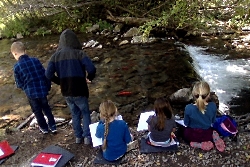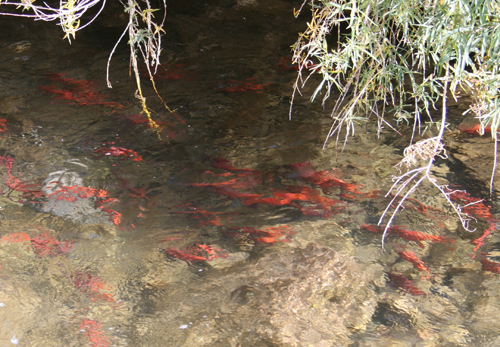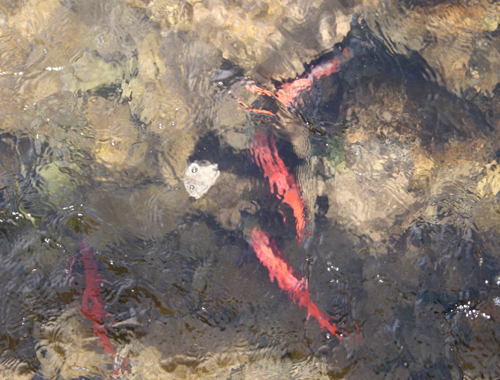
Courtesy & © Mary Heers, Photographer
Walking along the creek banks, looking down into the water, it’s impossible not to feel stirred by the spectacle of flashing red bodies fighting against the current. It’s a journey of fits and starts – a quick surge ahead and then a quivering pause. This is a real fight – the life energy of the fish against the relentless current. Just how difficult it is becomes apparent when the current will catch a fish and send it careening down steam until it recovers its balance and starts upstream again.

Courtesy & © Mary Heers, Photographer
Stopped from going further upstream, the female goes to work , using her tail to clear a nest of gravel. She lays her eggs and a nearby male swoops in and covers them with his milt. The female covers the fertilized eggs with more gravel and it is done. The Kokanee life cycle comes full circle, and the adults will die. The eggs are on their own. If all goes well, some will hatch in November. By April they will have grown into fingerlings and will get flushed downstream in the Spring run off. They will then spend the next few years in the reservoir before it is their turn to turn red and point their heads upstream.
The Department of Natural Resources originally stocked Kokanee into the reservoir as a sport fish. I asked a fisherman friend how one goes about catching a Kokanee, and he said you need a boat and a fish finder. The Kokanee live in schools about 30-50 feet below the surface, filling their bellies mostly by filtering zooplankton from the reservoir water. Once the fisherman finds the fish, he trolls right through the middle of the school with a shiny rectangle of metal called a dodger, along with pink and green plastic squid and a bit of colored corn. The fish strike the line out of anger, not out of hunger. “They’re a very tasty fish,” my friend said. “And a beautiful silver. We call it ‘catching chrome'” But for me the most beautiful color of Kokanee will always be the flash of red as it fights its way upstream. And the best taste will be the bit of awe and wonder we get as we catch a glimpse into this unique circle of life as it plays out in our natural world.

Courtesy & © Mary Heers, Photographer
Credits:
Photos: Courtesy & Copyright © Mary Heers
Photos: Courtesy
Featured Audio: Courtesy & Copyright © Friend Weller, Utah Public Radio upr.org
Text: Mary Heers, https://cca.usu.edu/files/awards/art-and-mary-heers-citation.pdf
Additional Reading: Lyle Bingham, https://bridgerlandaudubon.org/
Additional Reading
Wild About Utah, Mary Heers’ Wild About Utah Postings
Boling, Josh, Kokanee Salmon in Utah, Wild About Utah, October 9, 2017, https://wildaboututah.org/kokanee-salmon-in-utah/
Strand, Holly, Kokanee Life Cycle, Wild About Utah, September 19, 2013, https://wildaboututah.org/kokanee-life-cycle/
Strand, Holly, Kokanee Salmon, Wild About Utah, October 7, 2008, https://wildaboututah.org/kokanee-salmon/
9 places to see bright red kokanee salmon in Utah this fall, News, Utah Division of Wildlife Resources, Department of Natural Resources, State of Utah, September 1, 2019, https://wildlife.utah.gov/news/utah-wildlife-news/1003-see-red-kokanee-salmon.html
Fishing Guidebook 2021, Utah Division of Wildlife Resources, Department of Natural Resources, State of Utah, September 1, 2019, https://wildlife.utah.gov/guidebooks/2021_fishing_guidebook.pdf
Sockeye Salmon (Kokanee) – Oncorhynchus nerka, Utah Species, Utah Division of Wildlife Resources, Department of Natural Resources, State of Utah, 2019, https://fieldguide.wildlife.utah.gov/?species=oncorhynchus%20nerka
DeMoss, Jeffrey (with Eli Lucero underwater Kokanee photo), The journey home: Kokanee salmon make annual Cache spawning run, The Herald Journal,
Sep 17, 2015, https://www.hjnews.com/allaccess/the-journey-home-kokanee-salmon-make-annual-cache-spawning-run/article_235386ec-27a5-575f-872b-3702f3ded215.html
Ockey, Natalie, Kokanee Salmon Run in Utah. Utah’s Adventure Family, Last updated September 27, 2020, https://www.utahsadventurefamily.com/kokanee-salmon-run-in-utah/






